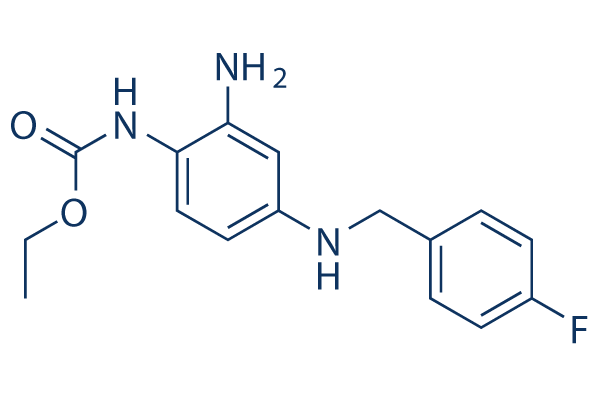|
受注:045-509-1970 |
技術サポート:[email protected] 平日9:00〜18:00 1営業日以内にご連絡を差し上げます |
化学情報

|
Synonyms | D-23129, N-(2-amino-4-[fluorobenzylamino]-phenyl) carbamic acid | Storage (From the date of receipt) |
3 years -20°C powder 1 years -80°C in solvent |
| 化学式 | C16H18FN3O2 |
|||
| 分子量 | 303.33 | CAS No. | 150812-12-7 | |
| Solubility (25°C)* | 体外 | DMSO | 69 mg/mL (227.47 mM) | |
| Ethanol | 15 mg/mL (49.45 mM) | |||
| Water | Insoluble | |||
|
* <1 mg/ml means slightly soluble or insoluble. * Please note that Selleck tests the solubility of all compounds in-house, and the actual solubility may differ slightly from published values. This is normal and is due to slight batch-to-batch variations. |
||||
溶剤液(一定の濃度)を調合する
生物活性
| 製品説明 | Retigabine (D-23129) is a novel anticonvulsant with activity in a broad range of seizure models. The mechanism of action involves opening of neuronal K(V)7.2-7.5 (formerly KCNQ2-5) voltage-activated K(+) channels. |
|---|---|
| in vitro | Retigabine is a novel antiepileptic drug whose mechanism of action involves potassium channel opening activity in neuronal cells. Retigabine can markedly enhance KCNQ2/Q3 currents. In addition, retigabine also enhances slow channel deactivation. Retigabine has been shown to increase the synthesis of GABA in rat hippocampal slices and to enhance GABA-induced chloride currents in cultured rat cortical neurons. Retigabine has been shown to induce membrane hyperpolarization in neurones in rat hippocampal-entorhinal cortex slices and to exert potassium channel opening activity in neuronal cells. Retigabine enhances a linopirdine-sensitive current in differentiated PC12 cells[1]. Concentrations of RTG/EZG ≥10 μM are required to cause significant augmentation of the GABAA receptor response. The potency of RTG/EZG differed somewhat depending on the GABAA receptor subunit combination, with the following rank order: α1β3γ2=α1β2γ2 >α3β2γ2=α2β2γ2>α5β2γ2=α1β2(N265S)γ2=α1β1γ2. RTG/EZG exhibits only weak inhibitory effects at voltage-gated Nav and Cav channel currents at predominantly supratherapeutic concentrations. RTG/EZG does not interact significantly with glutamate receptors[2]. |
| in vivo | Retigabine enhances γ-aminobutyric acid (GABA)-ergic transmission in the central nervous system[1]. Retigabine is rapidly absorbed and distributed with an oral bioavailability of 60% and a high volume of distribution of approximately 6.2 L/kg. Tolerability is good in humans when titrated up to its therapeutic dose range (600-1200 mg/day). Plasma protein binding of the drug is approximately 80%. The relatively high systemic bioavailability after oral administration suggests that retigabine is resistant to first-pass metabolism, a finding confirmed in multiple species. Retigabine is metabolized exclusively via phase II hepatic glucuronidation and acetylation. Gender differences in exposure have been noted, with female subjects exhibiting higher plasma concentrations of the drug after oral administration than male subjects. Excretion of retigabine appears to be predominantly renal. Depending on the behavioral endpoints analyzed, it appears that retigabine has a relatively poor therapeutic index (ratio between TD50 obtained in rotarod and ED50 obtained in maximal electroshock where maximal tonic extension of the hindlimbs was used as endpoint) in both mice (TD50/ED50 = 2.2) and rats (TD50/ED50 = 1.9) after i.p. administration. However, after p.o. administration in rats retigabine shows a therapeutic index of 28.8, which compares favorably with that reported for other antiepileptics, such as carbamazepine[4]. |
プロトコル(参考用のみ)
| 細胞アッセイ | 細胞株 | HEK293 cells |
|---|---|---|
| 濃度 | 0.1, 0.3, 1 or 3 μM | |
| 反応時間 | 4 h | |
| 実験の流れ | The retigabine incubation experiments are performed on HEK293 cells transfected with 10 ng KV2.1 over 48 h. 24 h post-transfection, HEK293 cells are either exposed to normal medium (control) containing 0.1% DMSO (vehicle control) or 0.1, 0.3, 1 or 3 μM retigabine for 4 h. After the 4 h exposure, the incubation medium is removed and fresh medium was added to the transfected HEK293 cells. Thus, at the moment of electrophysiological analysis (48 h post-transfection), no retigabine is present in the recording solution. |
|
| 動物実験 | 動物モデル | DBA/2 mice |
| 投薬量 | 0.5-20 mg/kg | |
| 投与方法 | i.p. |
参考
Selleckの高級品が、幾つかの出版された研究調査結果(以下を含む)で使われた:
| The SUMO-specific protease SENP2 plays an essential role in the regulation of Kv7.2 and Kv7.3 potassium channels [ J Biol Chem, 2021, S0021-9258(21)00985-6] | PubMed: 34509475 |
| The Changes of KCNQ5 Expression and Potassium Microenvironment in the Retina of Myopic Guinea Pigs [ Front Physiol, 2021, 12:790580] | PubMed: 35002772 |
| Structural Basis for the Modulation of Human KCNQ4 by Small-Molecule Drugs [ Mol Cell, 2020, S1097-2765(20)30771-1] | PubMed: 33238160 |
| Depolarization-Dependent C-Raf Signaling Promotes Hyperexcitability and Reduces Opioid Sensitivity of Isolated Nociceptors after Spinal Cord Injury [ J Neurosci, 2020, 40(34):6522-6535] | PubMed: 32690613 |
| Molecular basis and restoration of function deficiencies of Kv7.4 variants associated with inherited hearing loss. [ Hear Res, 2020, 388:107884] | PubMed: 31995783 |
| KCNQ2/3/5 channels in dorsal root ganglion neurons can be therapeutic targets of neuropathic pain in diabetic rats [ Mol Pain, 2018, 14:1744806918793229] | PubMed: 30027794 |
長期の保管のために-20°Cの下で製品を保ってください。
人間や獣医の診断であるか治療的な使用のためにでない。
各々の製品のための特定の保管と取扱い情報は、製品データシートの上で示されます。大部分のSelleck製品は、推薦された状況の下で安定です。製品は、推薦された保管温度と異なる温度で、時々出荷されます。長期の保管のために必要とされてそれと異なる温度で、多くの製品は、短期もので安定です。品質を維持するが、夜通しの積荷のために最も経済的な貯蔵状況を用いてあなたの送料を保存する状況の下に、製品が出荷されることを、我々は確実とします。製品の受領と同時に、製品データシートの上で貯蔵推薦に従ってください。
